Recreating the Country blog |
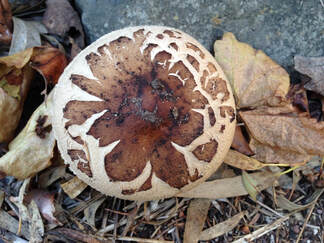 Fungi are important to the health of the majority of Australian plants Fungi are important to the health of the majority of Australian plants 'The interactions between plant roots and their symbiotic mycorrhizal fungi are quite intimate. Root exudates lure compatible fungal threads while deterring others that are not well-matched. The scientific literature is full of alluring words describing what comes next; entanglement, stimulus, penetration, intracellular exchange. The fungus ultimately forms an arbuscule (a tree-like structure) inside the plant root cells, specifically for the exchange of (nutrient-rich) fluids.' (A beautiful quote from mycologist Merlin Sheldrake, sourced through US organisation 'Real Organic'>) This week, after the soaking rains, I’ve noticed mushrooms and toadstools popping up in lawn areas in the town where I live. The exotic grass around these fungi is greener and at least 20% taller than the grass in nearby areas without fungi. This is a good example of a symbiotic relationship, where both the grass and the fungi are benefiting from growing together. The microbes associated with plants fall into five broad categories; the 'sexy' mycorrhizal fungi; the 'cocktail' of microbes that make up the microbiome of plants; nitrogen converting rhizobium bacteria; the 'harmful' parasitic fungi; and the 'soil building' saprophytic fungi.
This blog is about the microbes in categories 1,2 & 3, that are important to all living plants. 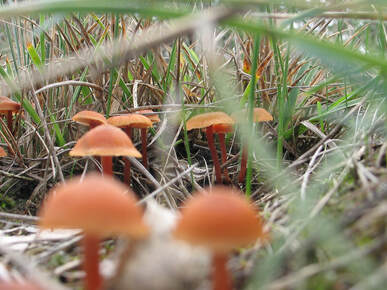 Up to 500 species of fungi can live in small patches of remnant bush. Up to 500 species of fungi can live in small patches of remnant bush. Mycorrhizal fungi An estimated 90% of Australian plant species have a positive association with mycorrhizal fungi that live on the roots of plants. They combine in a very intimate relationship where both the plant and the fungi need each other to live well. There are usually several hundred species of mycorrhizal fungi in a few hectares of remnant herb-land, grassland, woodland, or forest. Walking through these remnant areas, you will have noticed the many colours and shapes of fungi pushing through the leaf litter. These are the fruiting bodies of various mycorrhizal fungi. Just as the fruit on a fruit tree is only a small part of the whole tree, what we see decorating the forest floor is just a small part of an immense network of root-like mycelium growing deep under the soil surface. These mycelia literally feed the tree with nutrients such as nitrogen, phosphorus and many of the minerals they need and in return plants feed the fungi with the starches and sugars it makes through photosynthesis. Since only 10% of mycorrhizal fungi produce fruiting bodies that pop up in natural places, most of the fungi that live in the soil are invisible to us. They are either too small to see or they form ‘fruit’ under the soil, known as truffles. 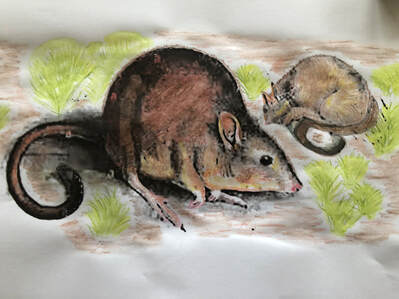 A sketch of two Eastern Bettongs, Bettongia gaimardi, foraging for fungi A sketch of two Eastern Bettongs, Bettongia gaimardi, foraging for fungi Mycorrhizal fungi and the truffle ‘junkies’. Thousands of plants, ranging from tiny orchids to huge eucalyptus species, benefit from this symbiotic relationship with fungi. In a Western Australian study, 500 different species of mycorrhizal fungi were identified in small patches of remnant bush. In a healthy forest or woodland system, these beneficial fungi are spread around by the scratching and digging of small marsupials like Bettongs and Potoroos. These small kangaroos complement their diets by eating the fruit of fungi, particularly the truffles. It has been shown that forest and woodland plants are healthier and more diverse where these small fungi-eating marsupials still survive to enhance these ecosystems. Fungi loving marsupials will play an important role in keeping remnants and new biodiversity plantings healthy in the future. Once our most common kangaroos, they have become either threatened or extinct in most of mainland Australia. And yes, loss of their protected habitat at ground level has contributed to this crisis, but foxes and feral cats are their biggest threat. 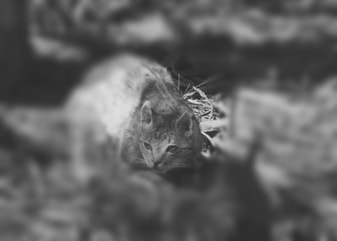 Exposing bettongs to a small population of feral cats makes the bettongs cat-shy. Exposing bettongs to a small population of feral cats makes the bettongs cat-shy. Boot camp for Burrowing Bettongs Protecting fungi spreading marsupials from predators like foxes and cats is a significant challenge that is generating some creative solutions. Predator-proof fencing has been around for decades, and it is very effective, though its high cost is often prohibitive. ($50,000/km in 2019) In the Sturt National Park, NSW, Ecologist Rebecca West is part of a team that has been training Burrowing Bettongs to avoid predators, and they’re getting results. Their most effective training method they refer to as ‘boot-camp for bettongs’. It sounds brutal to release a few feral cats into a 26 square kilometre fenced enclosure where the bettongs are living, but Rebecca and her team have found that they soon learn to avoid the cats. At first, the bettongs are naïve about the danger, but when they witness a bettong being killed and eaten, they quickly learn that cats are dangerous and that it’s smart to keep a safe distance. There is still a lot more to learn about designing the best boot camp for bettongs, but their initial trials are very encouraging.  Discover more about Victoria's Eastern Bettongs in a charming story that brings you the facts in an entertaining way (7-minute read); Eastern Bettongs - 'truffle junkies or ecosystem engineers'. 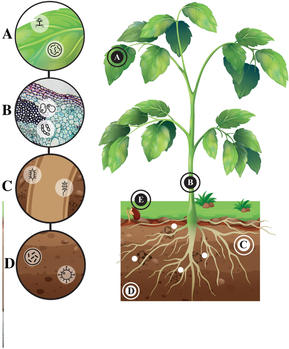 The microbiome occupies all parts of living plants. Image; World Journal of Microbiology and Biotechnology. The microbiome occupies all parts of living plants. Image; World Journal of Microbiology and Biotechnology. Plants have a microbiome. In the last decade, doctors have been emphasising the vital importance of the human microbiome to our health. These are the trillions of microscopic bacteria, viruses and fungi that live in our gut, on our skin, in our hair and in just about every part of the human body. In fact, more than half of the cells in our bodies are made up of these friendly, peace-loving, passengers that come along for the ride from the day we are born. Just as vital to plant health is their microbiome. Millions of microscopic bacteria and fungi live inside plants; their roots, stems, leaves, flowers and seed. These microbes are so important to a plant’s long-term health that they release specialised chemicals from their roots to invite them in. This cocktail of microbes is passed on to the next generation through a plant’s seed. So, a seed holds much more than the genetics of its parents, it also carries its parent’s microbiome. These specialist microbes are released when the seed germinates, and they enter its developing root system and start spreading throughout the plant. Dr Christine Jones, an expert in plant microbiology, puts it this way: “We now know that a seed has a core microbiome consisting of thousands of species of bacteria, archaea, fungi, and even some protists. The microbes in seeds are located inside the seed coat and surrounding the embryo. As the seed begins to germinate, they move into the radicle (primary root). Once the primary root has emerged, the first shoots appear. These too are colonised by microbes originating from the seed. As the plant grows, the core microbiome moves into the stems, leaves, flowers, fruits and eventually back into the seeds for the next generation." Remarkably, researchers have also shown that microbes from strong and healthy plants will move through the soil and into weaker neighbouring plants. They exchange their microbiome with other plants to help them through stressful times, however they’re quite fussy about which plants they help. They prefer to share their unique bacteria and fungi with plants from other plant families. Just as we benefit from living in human communities with wide-ranging skills and interests, plant communities that have evolved together as a diverse group benefit from this diversity. They try and maintain a variety of plant families in their communities by supporting struggling plants through tough times. Because of this constant sharing of fungi and bacteria, plants that live in a diverse plant community have more diverse microbiomes living in all of their plant parts. These richer microbiomes and the benefits that they provide are passed on to the next generation of plants in their seed. Christine Jones explains; “Microbes that begin in the seed are associated with plants through all stages of their growth and development. They are significant for nutrient acquisition and the production of plant-beneficial secondary metabolites that enhance tolerance to pests, disease and abiotic stresses such as contaminated soils or drought.” With revegetation works, Christine recommends including a minimum of 4 plant families to maximise the benefits of sharing and developing a more diverse microbiome. The flip side of this process is that plants from a depleted plant community will produce seeds with a depleted microbiome and a depleted ability to cope with stresses. Restoring the microbes The long-term survival of newly planted herb-lands, grasslands, woodlands, and forests will very likely depend on the presence of a collection of many types of mycorrhizal fungi and diverse plant microbiomes. Research in Western Australia and New South Wales has found that diverse fungal populations do not re-establish naturally in newly planted indigenous plantations. This is likely a reflection of the significant changes to soil chemistry after decades of grazing and cropping practices. The absence of the original mix of native plants has also depleted the soil of its associated mycorrhizae. The microbiomes in present-day native seed would also be depleted through the loss of so many important associations; plant to plant, plant to microbe, microbe to microbe. 'Though mycorrhizae are incredibly common (and functionally important) to land plants, they are in rapid decline. We are farming in ways that destroy these interactions, and we are now farming on half of the world’s land. Fertilizers, herbicides, and pesticides not only harm mycorrhizae, but they interfere with a plant's ability to form these relationships'. (Mycologist, Merlin Sheldrake) 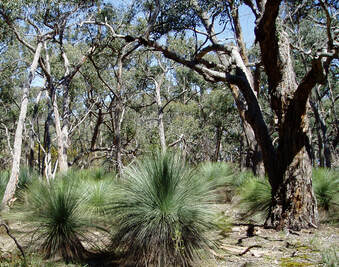 The natural bush is still home to thousands of microorganisms The natural bush is still home to thousands of microorganisms Creating links for soil microbes Creating links between patches of remnant bush by planting corridors of indigenous plants has the exciting potential to restore much of the lost mycorrhizal fungi. Remnants on roadsides and rivers and creeks, remnant patches on farms, small and large public reserves are all home to a diverse mix of an extraordinary variety of fungi and bacteria that once inhabited our entire Australian landscape. Planting a diverse mix of indigenous plants in an area that is linked to remnants, will modify the soil chemistry and microclimate through shade, wind shelter, the action and exudates from roots, the build-up of leaf litter, and the influence of the varieties of insects and birds that they attract. If we give the soil fungi avenues to spread, they are likely to use them, just as they have done for millennia, particularly when the soil environment begins to restore to its former character. Microorganisms have very effective airborne methods of spreading their spores and if we provide them with a suitable growing environment, they will surely adopt their new homes and flourish. An important part of change to soils will be the lowering of Nitrogen and Phosphorus to pre-European levels. Research has clearly shown that elevated soil Phosphorus suppresses mycorrhizal activity. 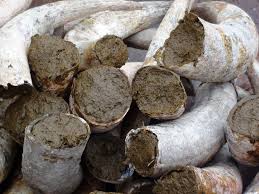 500 is made from cow manure aged in cow horns 500 is made from cow manure aged in cow horns Biostimulants. Biodynamic farmers inoculate their cropping and grazing paddocks with a dilute preparation called '500' which is made from aged cow manure. This is sprayed on cloudy days or at night to allow the microorganisms in the 500 to establish before sunshine makes contact with the soil and kills any microbes and spores that are still exposed. Organic growers inoculate seed with bio-stimulants sprayed onto dry seed before sowing. These can be made by diluting vermi-liquid to produce worm tea, or by soaking mature compost and adding water to make a compost tea. These liquids are rich in a diverse mix of microbes that benefit growing plants. 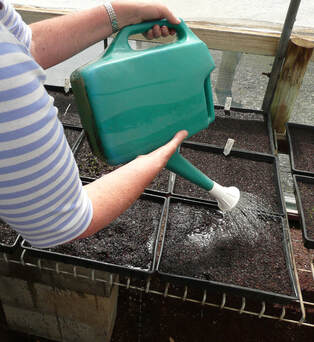 Nodules of rhyzobium bacteria living on the roots of a Golden Wattle are crushed to inoculate GW seed sown in a tray Nodules of rhyzobium bacteria living on the roots of a Golden Wattle are crushed to inoculate GW seed sown in a tray Rhizobium bacteria. Another group of microorganisms that are important to plants are Rhizobium bacteria. These bacteria absorb atmospheric nitrogen and enable the legume plant families to absorb nitrogen through their roots. The families that directly benefit from this relationship include members of the Mimosaceae (e.g. wattles) and Caesalpiniaceae (e.g. cassias) and Fabaceae (e.g. davesia, dillwynia, indigophora, kennedia). The rhizobium bacteria live in nodules, which look like tiny potatoes, attached to the outside of the plant’s roots. Plants from these families can be successfully inoculated with rhizobium bacteria in the nursery before planting in the field. This is done by crushing nodules collected from seedling plants of the same species, (the nodules contain thousands of rhizobia) and adding the juice to water in a watering-can which is then watered over seedling trays when the seed is germinating. The rhizobia attach to the roots of the developing plants and support more vigorous growth when they are planted in soil. Other plant species growing nearby also benefit from the extra nitrogen that is added to the soil by these native legume plants.  The microbial necromass is the accumulation cell residues and dead microbe cells. Kate M. Buckeridge, Courtney Creamer, Jeanette Whitaker. February 2022. The microbial necromass is the accumulation cell residues and dead microbe cells. Kate M. Buckeridge, Courtney Creamer, Jeanette Whitaker. February 2022. The microbial necromass - the largest land storage of carbon Deep under the soil, where oxygen is in short supply, there is an important though little known storage of carbon. In fact, it is where most organic soil carbon is stored more or less permanently. This makes it critically importance for carbon sequestration. It has been described as the largest store of carbon on land. At these deeper levels in the soil, it is efficiently recycled and contributes to the growth of the overall microbial biomass. It can provide up to 80% of the soil's organic matter. The microbial necromass is the accumulated remains of dead microbial cells and root cell fragments. It is permanent in the soil because the low levels of oxygen at deeper levels protect it from microbial decomposition. Necromass residues include dead microbe cells and their hyphae, fragments of cell walls plus the sugars, proteins, enzymes and DNA associated with microbial life. Land managers can increase soil carbon by optimizing necromass formation and by making it a critical component of efforts to minimise the effects of climate change. Sadly, they were toxic Yellow-stainers. I did get excited when I saw the enticing fairy-rings of mushrooms growing on roadside verges, but sadly it seems that good mushrooms are hard to find these days. On closer inspection, they turned out to be the toxic 'Yellow-stainers.’ Though it seems that the various exotic grasses growing with them didn’t find them toxic and actually benefit from being up close and cuddly. I'll take some solace though from knowing that the fresh lettuce and parsley that I put in my salad is full of the living microorganisms that make up the microbiomes of these plants. No doubt they will add diversity to my own flourishing gut flora and support my immunity in these covid times. To read more on fungi, how and where they grow, try the Australian National Botanic Gardens site. https://www.anbg.gov.au/fungi/what-is-fungus.html Also, the Interactive catalogue of Australian Fungi has some excellent photos. https://www.inaturalist.org/projects/fungimap-australia Current research into life in our soils -
You can be a citizen scientist and play a part, To care for our soils, we need to know more about them. While we know the life in our soils is in trouble, we need to know more. One important finding from the State of the Environment report was the need for more data on the biology of our soil to aid sustainable land use. Why? To date, most of our understanding of how farming impacts soil fungal diversity is based on overseas research. Despite the ecological importance of microbiota and their potential to accelerate sustainable food production, we still don’t have a clear picture of what mycorrhizal fungi live in Australia. To overcome this challenge, the Australian Research Council have launched 'Dig Up Dirt', a new nationwide research project designed to take stock of our beneficial soil fungi. Farmers, land managers and citizen scientists can send in soil samples so that Australia’s networks of soil fungi can be mapped. The data collected will also be fed into the international database - map fungi globally. This is a long-overdue step towards understanding soil fungi and conserving the life below our feet.
2 Comments
Dale
25/7/2022 01:16:14 pm
Another great blog post Steve. Keep up the good work.
Reply
Steve
25/7/2022 10:25:04 pm
So glad you found my discourse on microbes worthwhile Dale. No doubt there will be plenty to view in the grassy woodlands at Teesdale this spring.
Reply
Leave a Reply. |
Click on the image below to discover 'Recreating the Country' the book.
Stephen Murphy is an author, an ecologist and a nurseryman. He has been a designer of natural landscapes for over 30 years. He loves the bush, supports Landcare and is a volunteer helping to conserve local reserves.
He continues to write about ecology, natural history and sustainable biorich landscape design. 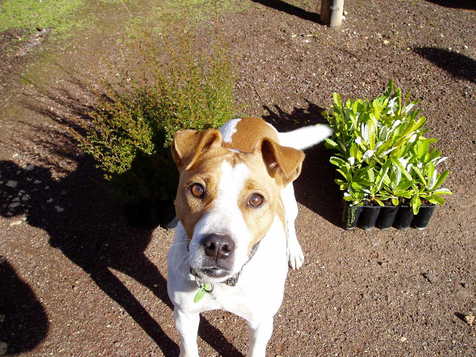
|
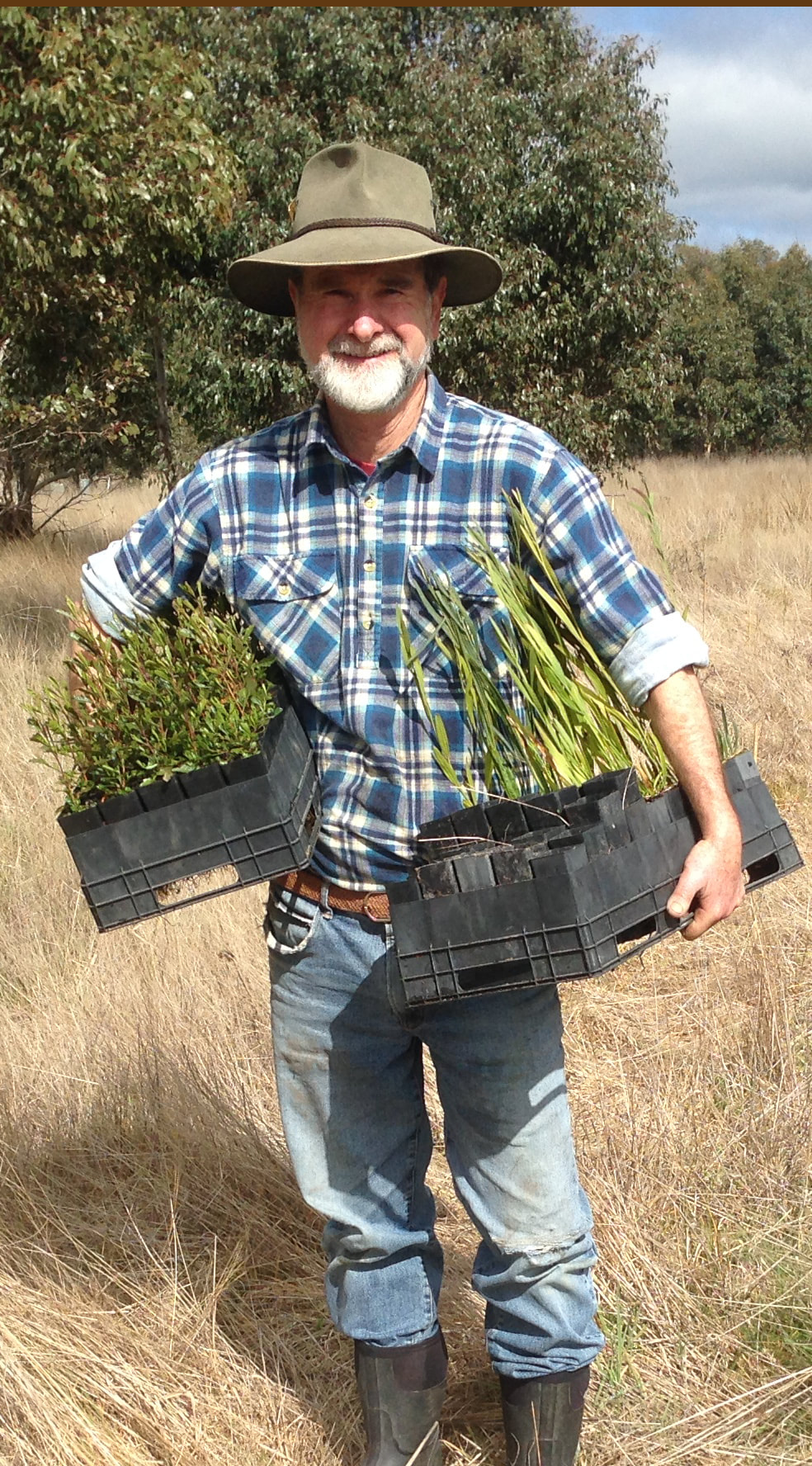

 RSS Feed
RSS Feed
